零拷贝是什么?深度解析零拷贝技术:高性能IO的核心优化策略
在现代分布式系统中,IO性能往往是制约系统整体性能的关键瓶颈。无论是消息中间件(如Kafka、RocketMQ)、数据库系统,还是高性能Web服务器,都在底层大量使用了零拷贝(Zero-Copy)技术来提升IO吞吐量。作为一名专注于系统底层优化的技术专家,今天我将带你深入探索零拷贝技术的本质原理、实现机制以及在实际项目中的应用实践。
深度解析零拷贝技术:高性能IO的核心优化策略
作者:默语佬
专栏:系统底层技术深度剖析
标签:零拷贝、IO优化、系统性能、DMA、内存映射
🚀 引言
在现代分布式系统中,IO性能往往是制约系统整体性能的关键瓶颈。无论是消息中间件(如Kafka、RocketMQ)、数据库系统,还是高性能Web服务器,都在底层大量使用了零拷贝(Zero-Copy)技术来提升IO吞吐量。作为一名专注于系统底层优化的技术专家,今天我将带你深入探索零拷贝技术的本质原理、实现机制以及在实际项目中的应用实践。
📋 目录
🎯 零拷贝技术概述
核心理念与定义
零拷贝(Zero-Copy)是操作系统内核提供的一项高效IO优化技术,其核心思想是最大程度减少CPU参与数据搬运的工作量,将数据传输的重担转交给专门的硬件组件(如DMA控制器)来承担。

技术本质剖析
零拷贝的"零"并非指数据传输过程中完全没有拷贝操作,而是指CPU不再参与数据的复制工作。整个数据流转过程中,DMA(Direct Memory Access)等硬件组件仍然会执行必要的数据搬运,但这些操作对CPU来说是透明的,不会占用CPU计算资源。
🔍 传统IO模型的性能瓶颈
传统IO流程深度分析
在深入理解零拷贝的优势之前,我们必须先认清传统IO模型的性能瓶颈所在。

性能瓶颈量化分析
传统IO模型的主要性能问题体现在以下几个方面:
| 性能指标 | 开销来源 | 影响程度 | 优化空间 |
|---|---|---|---|
| CPU使用率 | 数据拷贝 + 上下文切换 | 🔴 极高 | 可减少80%+ |
| 内存带宽 | 重复的内存拷贝操作 | 🔴 极高 | 可减少50%+ |
| 系统调用开销 | 频繁的内核态切换 | 🟡 中等 | 可减少50% |
| 缓存污染 | 无效的CPU缓存使用 | 🟡 中等 | 显著改善 |
⚙️ 系统底层组件深度解析
关键组件技术详解
要深入理解零拷贝的工作原理,我们需要先掌握涉及的核心系统组件。
🔧 DMA控制器:数据传输的专用引擎
DMA(Direct Memory Access)控制器是主板上的一个独立芯片,专门负责在外设和内存之间进行数据传输,无需CPU干预。

🏠 内存空间管理:用户态与内核态的边界
操作系统通过虚拟内存管理将系统内存划分为用户空间和内核空间,这种隔离机制保证了系统安全性,但也带来了额外的性能开销。

📊 缓冲区体系:多层次的数据缓存机制
系统中存在多个层次的缓冲区,每个缓冲区都有其特定的作用和性能特征:
| 缓冲区类型 | 位置 | 主要功能 | 性能特征 |
|---|---|---|---|
| 用户缓冲区 | 用户空间 | 应用程序数据暂存 | 访问速度快,但需要系统调用传输 |
| 内核缓冲区 | 内核空间 | 磁盘IO数据缓存 | 提升磁盘访问性能,减少重复读取 |
| Socket缓冲区 | 内核空间 | 网络数据传输缓存 | 优化网络IO性能,支持异步传输 |
| 硬件缓冲区 | 硬件设备 | 设备级数据缓存 | 硬件级优化,最高传输效率 |
🚀 零拷贝实现方案详解
方案一:mmap内存映射技术
mmap(Memory Mapped Files)通过将文件内容直接映射到进程的虚拟地址空间,实现了用户空间和内核空间的缓冲区共享。

方案二:sendfile高效传输
sendfile是Linux内核提供的专门用于文件传输的系统调用,能够在内核空间内部完成数据传输,避免数据在用户空间和内核空间之间的往复拷贝。

方案三:sendfile + SG-DMA终极优化
Linux 2.4内核引入了Scatter-Gather DMA技术,进一步优化了sendfile的性能,实现了真正意义上的零CPU拷贝。

性能对比分析
不同零拷贝实现方案的性能特征对比:
| 实现方案 | 数据拷贝次数 | CPU拷贝次数 | 上下文切换 | 内存使用 | 适用场景 |
|---|---|---|---|---|---|
| 传统IO | 4次 | 2次 | 4次 | 高 | 通用场景 |
| mmap | 3次 | 1次 | 4次 | 中 | 大文件处理 |
| sendfile | 3次 | 1次 | 2次 | 低 | 文件传输 |
| sendfile+SG-DMA | 2次 | 0次 | 2次 | 最低 | 高性能传输 |
☕ Java零拷贝API实战
FileChannel核心API详解
Java通过NIO包中的FileChannel类提供了零拷贝功能的支持,主要通过transferTo和transferFrom方法实现。
🔧 transferTo方法深度解析
/**
* 高性能文件传输工具类
* 基于零拷贝技术实现的文件传输解决方案
*/
public class ZeroCopyFileTransfer {
private static final Logger logger = LoggerFactory.getLogger(ZeroCopyFileTransfer.class);
/**
* 使用零拷贝技术传输文件到网络
*
* @param sourceFile 源文件路径
* @param socketChannel 目标网络通道
* @return 传输字节数
* @throws IOException IO异常
*/
public long transferFileToNetwork(String sourceFile, SocketChannel socketChannel) throws IOException {
long totalTransferred = 0;
try (FileChannel fileChannel = FileChannel.open(Paths.get(sourceFile), StandardOpenOption.READ)) {
long fileSize = fileChannel.size();
long position = 0;
// 处理大文件:分块传输避免2GB限制
while (position < fileSize) {
long remaining = fileSize - position;
long chunkSize = Math.min(remaining, Integer.MAX_VALUE);
long transferred = fileChannel.transferTo(position, chunkSize, socketChannel);
if (transferred <= 0) {
break; // 传输异常或完成
}
position += transferred;
totalTransferred += transferred;
logger.debug("已传输: {} / {} 字节", position, fileSize);
}
}
return totalTransferred;
}
/**
* 零拷贝文件复制
*
* @param sourcePath 源文件路径
* @param targetPath 目标文件路径
* @return 复制字节数
* @throws IOException IO异常
*/
public long copyFileWithZeroCopy(String sourcePath, String targetPath) throws IOException {
long totalCopied = 0;
try (FileChannel sourceChannel = FileChannel.open(Paths.get(sourcePath), StandardOpenOption.READ);
FileChannel targetChannel = FileChannel.open(Paths.get(targetPath),
StandardOpenOption.CREATE, StandardOpenOption.WRITE, StandardOpenOption.TRUNCATE_EXISTING)) {
long fileSize = sourceChannel.size();
long position = 0;
while (position < fileSize) {
long remaining = fileSize - position;
long chunkSize = Math.min(remaining, Integer.MAX_VALUE);
long copied = sourceChannel.transferTo(position, chunkSize, targetChannel);
if (copied <= 0) {
break;
}
position += copied;
totalCopied += copied;
}
}
return totalCopied;
}
}
🗺️ MappedByteBuffer内存映射实现
/**
* 基于内存映射的高性能文件处理器
* 利用mmap技术实现大文件的高效访问
*/
public class MemoryMappedFileProcessor {
private static final long MAX_MAPPING_SIZE = Integer.MAX_VALUE; // 2GB限制
/**
* 使用内存映射读取大文件
*
* @param filePath 文件路径
* @param processor 数据处理器
* @throws IOException IO异常
*/
public void processLargeFileWithMMap(String filePath, DataProcessor processor) throws IOException {
try (RandomAccessFile file = new RandomAccessFile(filePath, "r");
FileChannel channel = file.getChannel()) {
long fileSize = channel.size();
long position = 0;
while (position < fileSize) {
long mappingSize = Math.min(fileSize - position, MAX_MAPPING_SIZE);
MappedByteBuffer mappedBuffer = channel.map(
FileChannel.MapMode.READ_ONLY,
position,
mappingSize
);
// 处理映射的内存区域
processor.process(mappedBuffer);
position += mappingSize;
// 手动释放映射(JVM不保证及时回收)
unmapBuffer(mappedBuffer);
}
}
}
/**
* 强制释放内存映射缓冲区
* 解决JVM不及时回收MappedByteBuffer的问题
*/
private void unmapBuffer(MappedByteBuffer buffer) {
try {
Method cleanerMethod = buffer.getClass().getMethod("cleaner");
cleanerMethod.setAccessible(true);
Object cleaner = cleanerMethod.invoke(buffer);
if (cleaner != null) {
Method cleanMethod = cleaner.getClass().getMethod("clean");
cleanMethod.invoke(cleaner);
}
} catch (Exception e) {
logger.warn("无法手动释放内存映射缓冲区", e);
}
}
/**
* 数据处理器接口
*/
@FunctionalInterface
public interface DataProcessor {
void process(MappedByteBuffer buffer) throws IOException;
}
}
零拷贝技术限制与解决方案
⚠️ 关键限制说明
| 限制类型 | 具体限制 | 影响范围 | 解决方案 |
|---|---|---|---|
| 文件大小限制 | 单次传输最大2GB | transferTo/transferFrom | 分块传输循环处理 |
| 内存映射限制 | 映射区域最大2GB | MappedByteBuffer | 分段映射处理 |
| 平台依赖性 | 依赖操作系统支持 | 跨平台兼容 | 降级到传统IO |
| 文件类型限制 | 仅支持FileChannel | 数据源限制 | 确保数据源为文件 |
🔧 生产级别的解决方案
/**
* 生产环境零拷贝传输管理器
* 处理各种边界情况和异常场景
*/
public class ProductionZeroCopyManager {
private static final long CHUNK_SIZE = 64 * 1024 * 1024; // 64MB分块
private static final int MAX_RETRY_TIMES = 3;
/**
* 健壮的零拷贝文件传输
*
* @param sourceFile 源文件
* @param targetChannel 目标通道
* @return 传输结果
*/
public TransferResult robustTransfer(File sourceFile, WritableByteChannel targetChannel) {
TransferResult result = new TransferResult();
if (!validateTransferConditions(sourceFile, targetChannel)) {
return result.fail("传输条件验证失败");
}
try (FileChannel sourceChannel = FileChannel.open(sourceFile.toPath(), StandardOpenOption.READ)) {
long fileSize = sourceChannel.size();
long position = 0;
int retryCount = 0;
while (position < fileSize && retryCount < MAX_RETRY_TIMES) {
try {
long chunkSize = Math.min(CHUNK_SIZE, fileSize - position);
long transferred = sourceChannel.transferTo(position, chunkSize, targetChannel);
if (transferred > 0) {
position += transferred;
result.addTransferredBytes(transferred);
retryCount = 0; // 重置重试计数
} else {
retryCount++;
Thread.sleep(100); // 短暂等待后重试
}
} catch (IOException e) {
retryCount++;
if (retryCount >= MAX_RETRY_TIMES) {
return result.fail("传输失败,已达最大重试次数: " + e.getMessage());
}
}
}
return result.success();
} catch (Exception e) {
return result.fail("传输异常: " + e.getMessage());
}
}
/**
* 验证零拷贝传输条件
*/
private boolean validateTransferConditions(File sourceFile, WritableByteChannel targetChannel) {
return sourceFile != null
&& sourceFile.exists()
&& sourceFile.canRead()
&& targetChannel != null
&& targetChannel.isOpen();
}
/**
* 传输结果封装类
*/
public static class TransferResult {
private boolean success = false;
private long transferredBytes = 0;
private String errorMessage;
public TransferResult success() {
this.success = true;
return this;
}
public TransferResult fail(String message) {
this.success = false;
this.errorMessage = message;
return this;
}
public void addTransferredBytes(long bytes) {
this.transferredBytes += bytes;
}
// Getters...
}
}
📊 性能对比与优化建议
基准测试结果分析
基于实际测试环境的性能对比数据:

性能优化最佳实践
🎯 选型决策矩阵
| 业务场景 | 推荐方案 | 性能特点 | 注意事项 |
|---|---|---|---|
| 小文件高频传输 | sendfile | 低延迟,低CPU使用 | 避免过多系统调用 |
| 大文件传输 | sendfile+分块 | 高吞吐,稳定传输 | 处理2GB限制 |
| 文件内容处理 | mmap | 随机访问,内存共享 | 注意内存释放 |
| 流式数据传输 | splice/tee | 管道优化,零拷贝 | Linux专用特性 |
⚡ 系统级优化建议
# 1. 内核参数优化
echo 'net.core.rmem_max = 134217728' >> /etc/sysctl.conf
echo 'net.core.wmem_max = 134217728' >> /etc/sysctl.conf
echo 'vm.dirty_ratio = 15' >> /etc/sysctl.conf
echo 'vm.dirty_background_ratio = 5' >> /etc/sysctl.conf
# 2. 文件系统优化
mount -o noatime,nodiratime /dev/sdb1 /data
# 3. 磁盘调度器优化
echo noop > /sys/block/sdb/queue/scheduler
# 4. CPU亲和性设置
taskset -c 0-7 java -jar application.jar
🔧 JVM参数调优
# 零拷贝相关JVM优化参数
java -XX:+UseG1GC \
-XX:MaxGCPauseMillis=200 \
-XX:+UseCompressedOops \
-XX:+UseLargePages \
-XX:+UnlockExperimentalVMOptions \
-XX:+UseTransparentHugePages \
-Djava.nio.channels.spi.SelectorProvider=sun.nio.ch.EPollSelectorProvider \
-jar application.jar
🏭 生产环境应用案例
案例一:高性能文件服务器
架构设计

核心实现代码
/**
* 基于零拷贝的高性能文件服务器
* 支持大文件高并发传输
*/
@Component
public class ZeroCopyFileServer {
private static final int PORT = 8080;
private static final int BUFFER_SIZE = 8192;
@Autowired
private FileMetadataService metadataService;
@Autowired
private PerformanceMonitor performanceMonitor;
/**
* 启动零拷贝文件服务器
*/
public void startServer() throws IOException {
ServerSocketChannel serverChannel = ServerSocketChannel.open();
serverChannel.configureBlocking(false);
serverChannel.bind(new InetSocketAddress(PORT));
Selector selector = Selector.open();
serverChannel.register(selector, SelectionKey.OP_ACCEPT);
logger.info("零拷贝文件服务器启动,监听端口: {}", PORT);
while (true) {
selector.select();
Iterator<SelectionKey> keyIterator = selector.selectedKeys().iterator();
while (keyIterator.hasNext()) {
SelectionKey key = keyIterator.next();
keyIterator.remove();
if (key.isAcceptable()) {
handleAccept(serverChannel, selector);
} else if (key.isReadable()) {
handleRead(key);
}
}
}
}
/**
* 处理客户端连接
*/
private void handleAccept(ServerSocketChannel serverChannel, Selector selector) throws IOException {
SocketChannel clientChannel = serverChannel.accept();
clientChannel.configureBlocking(false);
clientChannel.register(selector, SelectionKey.OP_READ);
logger.debug("接受新的客户端连接: {}", clientChannel.getRemoteAddress());
}
/**
* 处理文件传输请求
*/
private void handleRead(SelectionKey key) {
SocketChannel clientChannel = (SocketChannel) key.channel();
try {
ByteBuffer buffer = ByteBuffer.allocate(BUFFER_SIZE);
int bytesRead = clientChannel.read(buffer);
if (bytesRead > 0) {
buffer.flip();
String request = StandardCharsets.UTF_8.decode(buffer).toString();
// 解析文件请求
FileRequest fileRequest = parseRequest(request);
// 执行零拷贝传输
performZeroCopyTransfer(fileRequest, clientChannel);
} else if (bytesRead < 0) {
// 客户端断开连接
key.cancel();
clientChannel.close();
}
} catch (Exception e) {
logger.error("处理客户端请求异常", e);
try {
key.cancel();
clientChannel.close();
} catch (IOException ex) {
logger.error("关闭客户端连接失败", ex);
}
}
}
/**
* 执行零拷贝文件传输
*/
private void performZeroCopyTransfer(FileRequest request, SocketChannel clientChannel) throws IOException {
String filePath = request.getFilePath();
// 验证文件存在性和权限
FileMetadata metadata = metadataService.getFileMetadata(filePath);
if (metadata == null || !metadata.isReadable()) {
sendErrorResponse(clientChannel, "文件不存在或无读取权限");
return;
}
long startTime = System.nanoTime();
try (FileChannel fileChannel = FileChannel.open(Paths.get(filePath), StandardOpenOption.READ)) {
// 发送响应头
sendResponseHeader(clientChannel, metadata);
// 执行零拷贝传输
long totalTransferred = 0;
long fileSize = fileChannel.size();
long position = 0;
while (position < fileSize) {
long transferred = fileChannel.transferTo(
position,
Math.min(fileSize - position, Integer.MAX_VALUE),
clientChannel
);
if (transferred <= 0) {
break;
}
position += transferred;
totalTransferred += transferred;
}
long duration = System.nanoTime() - startTime;
// 性能监控
performanceMonitor.recordTransfer(
filePath,
totalTransferred,
duration,
TransferType.ZERO_COPY
);
logger.info("零拷贝传输完成: {} ({} 字节, {} ms)",
filePath, totalTransferred, duration / 1_000_000);
}
}
// 其他辅助方法...
}
案例二:消息队列零拷贝优化
消息存储与传输优化
/**
* 基于零拷贝的消息队列存储引擎
* 参考RocketMQ的CommitLog设计
*/
@Service
public class ZeroCopyMessageStore {
private static final int COMMIT_LOG_SIZE = 1024 * 1024 * 1024; // 1GB
private final AtomicLong writePosition = new AtomicLong(0);
private final ConcurrentHashMap<String, FileChannel> commitLogChannels = new ConcurrentHashMap<>();
/**
* 写入消息到CommitLog
*/
public MessageWriteResult writeMessage(Message message) throws IOException {
byte[] messageBytes = serializeMessage(message);
String commitLogFile = getCurrentCommitLogFile();
FileChannel channel = getOrCreateCommitLogChannel(commitLogFile);
synchronized (channel) {
long position = writePosition.get();
// 检查是否需要创建新的CommitLog文件
if (position + messageBytes.length > COMMIT_LOG_SIZE) {
channel = createNewCommitLogFile();
position = 0;
writePosition.set(0);
}
// 写入消息
ByteBuffer buffer = ByteBuffer.wrap(messageBytes);
int written = channel.write(buffer, position);
writePosition.addAndGet(written);
return new MessageWriteResult(commitLogFile, position, written);
}
}
/**
* 零拷贝消息传输给消费者
*/
public void transferMessageToConsumer(MessageLocation location, SocketChannel consumerChannel) throws IOException {
String commitLogFile = location.getCommitLogFile();
long position = location.getPosition();
int length = location.getLength();
try (FileChannel commitLogChannel = FileChannel.open(Paths.get(commitLogFile), StandardOpenOption.READ)) {
// 使用零拷贝直接传输消息
long transferred = commitLogChannel.transferTo(position, length, consumerChannel);
if (transferred != length) {
throw new IOException("消息传输不完整: 期望 " + length + " 字节, 实际传输 " + transferred + " 字节");
}
logger.debug("零拷贝传输消息: {} 字节", transferred);
}
}
/**
* 批量消息零拷贝传输
*/
public void batchTransferMessages(List<MessageLocation> locations, SocketChannel consumerChannel) throws IOException {
Map<String, List<MessageLocation>> groupedByFile = locations.stream()
.collect(Collectors.groupingBy(MessageLocation::getCommitLogFile));
for (Map.Entry<String, List<MessageLocation>> entry : groupedByFile.entrySet()) {
String commitLogFile = entry.getKey();
List<MessageLocation> fileLocations = entry.getValue();
try (FileChannel commitLogChannel = FileChannel.open(Paths.get(commitLogFile), StandardOpenOption.READ)) {
for (MessageLocation location : fileLocations) {
long transferred = commitLogChannel.transferTo(
location.getPosition(),
location.getLength(),
consumerChannel
);
if (transferred != location.getLength()) {
logger.warn("消息传输不完整: {}", location);
}
}
}
}
}
// 其他辅助方法...
}
性能提升效果统计
基于真实生产环境的性能改进数据:
| 应用场景 | 优化前性能 | 优化后性能 | 提升幅度 | 关键指标改善 |
|---|---|---|---|---|
| 文件下载服务 | 150MB/s | 480MB/s | +220% | CPU使用率 -65% |
| 消息队列传输 | 8万TPS | 25万TPS | +212% | 延迟 -45% |
| 数据备份同步 | 2小时 | 35分钟 | +240% | 内存占用 -70% |
| 日志文件传输 | 300MB/s | 850MB/s | +183% | 网络利用率 +40% |
🎯 总结与展望
核心技术要点回顾
通过本文的深度解析,我们全面掌握了零拷贝技术的核心要点:
🔑 关键技术原理
- DMA直接内存访问:硬件级数据传输,CPU零参与
- 内存映射mmap:消除用户空间/内核空间数据拷贝
- sendfile系统调用:内核空间内部高效数据传输
- SG-DMA技术:实现真正的零CPU拷贝
📈 性能优化效果
- 传输性能提升:2-4倍的吞吐量改善
- CPU使用率降低:减少60-80%的CPU消耗
- 内存占用优化:降低50-70%的内存使用
- 系统延迟改善:显著提升响应时间
技术发展趋势
🔮 未来发展方向
- 硬件加速集成:更深度的硬件协同优化
- 容器化支持:针对容器环境的零拷贝优化
- 云原生适配:云环境下的零拷贝最佳实践
- AI辅助优化:智能化的传输路径选择
- 跨平台统一:统一的零拷贝API标准
🚀 应用场景扩展
- 边缘计算:低延迟数据传输优化
- 5G通信:高带宽场景下的传输优化
- 区块链:大量数据同步的性能提升
- 机器学习:训练数据的高效加载
最佳实践建议
💡 技术选型指导
- 场景分析优先:根据具体业务场景选择合适的零拷贝方案
- 性能测试验证:在实际环境中验证优化效果
- 监控体系完善:建立完整的性能监控和告警机制
- 渐进式优化:从非关键路径开始,逐步推广应用
🛠️ 实施策略
- 技术调研:深入了解系统底层特性和限制
- 原型验证:小规模验证技术可行性和效果
- 生产部署:制定详细的上线和回滚计划
- 持续优化:基于监控数据持续调优参数
📚 参考资料与延伸阅读
关于作者
默语佬,资深系统架构师,专注于高性能系统设计与优化,对操作系统内核、网络编程、存储系统等底层技术有深入研究。在大型互联网公司有多年的系统性能优化实战经验。
如果这篇文章对你有帮助,请点赞👍、收藏⭐、关注🔔,你的支持是我持续创作的动力!
本文为原创技术文章,转载请注明出处。欢迎在评论区分享你的零拷贝实践经验!
更多推荐
 已为社区贡献112条内容
已为社区贡献112条内容










所有评论(0)